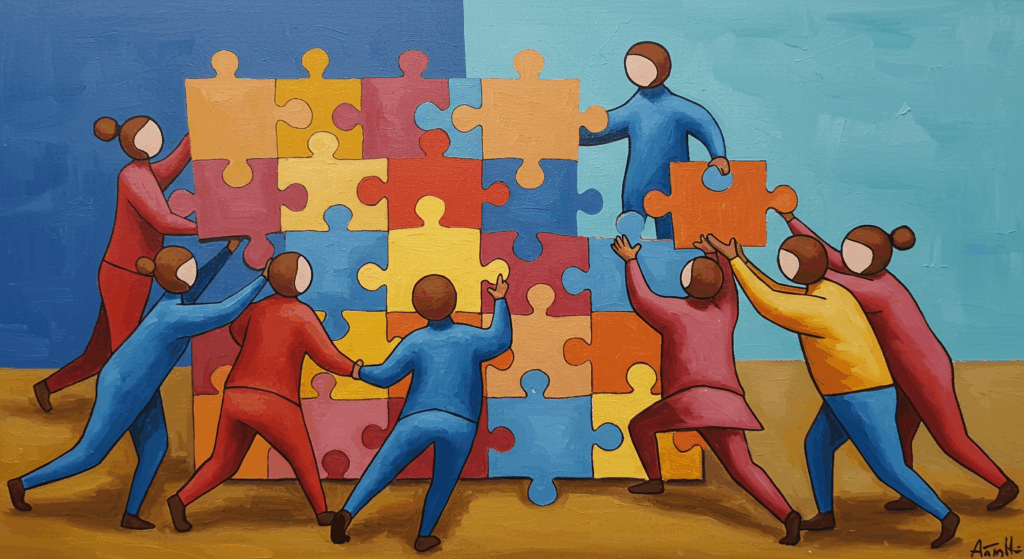Let’s be honest: some team building ideas feel like they were invented by a bored spreadsheet in 1998. If the words “trust fall” make your soul gently leave your body, same. But team building doesn’t have to be cringe or corporate-y. Done right, it’s basically hanging out with cool coworkers, learning a few things about each other, and laughing in a way that’s good for morale and productivity. Think of it like a playlist: you want a few bangers, a couple of chill tracks, and some unexpected remixes — so everyone finds a groove.
In this guide, I’m sharing fun team building exercises that actually hit. They’re low on awkwardness, high on connection, and easy to run whether you’re in-person, hybrid, or fully remote. We’ll mix quick warm-ups, creative bits (hello, improv games), mindfulness-ish moments like laughter yoga, and some fun competitions that are friendly, not cutthroat. The goal: leave people feeling energized, not exhausted. Deal? Let’s roll.
Why “Fun” Matters More Than You Think
Workplace vibes are wild sometimes. Half your team is juggling deadlines, two tools suddenly want 17 new permissions, and somebody used a 200MB image in a slide deck. When stress is the default, fun team building exercises can feel like fluff. But here’s the thing: fun is a delivery system for trust, collaboration, and psychological safety. If we feel safe and seen, we share ideas faster, take smarter risks, and hold each other down when things get messy (which they will, because life).
Also — fun lowers the pressure to “perform.” You don’t need a perfect agenda or the world’s most charismatic facilitator. You just need activities that are clear, inclusive, and chill enough that people actually relax.
Quick checklist for “fun that works”:
- Simple mechanics: Short instructions, no tedious rules.
- Low embarrassment: No forced sharing of trauma or singing solos (unless your team is into that, then rock on).
- Short bursts: Rotate activities before attention lags.
- Inclusive by default: Multiple ways to participate; no need to be loud to be valued.
The Warm-Up Zone: Zero-Cringe Icebreakers
You don’t want to start with a 45-minute lecture about synergy. You want something that spark-starts the room. These take 5–10 minutes each and work with any group size.
“One Word Weather”
Everyone describes their mood like a forecast: “Partly sunny with a caffeine front incoming.” It’s quick, funny, and gives you a vibe check without being invasive.
Why it works: It normalizes being human. Also, weather is universal — no prep needed.
Remote twist: Use emoji-only forecasts in chat. 🌤️🌪️☕️
“Two Truths, One Exaggeration”
Like “Two Truths and a Lie” but less stressful. The “lie” becomes a dramatic, obvious exaggeration: “I once wrestled a raccoon for a croissant.”
Why it works: Encourages humor without burdening people to be detectives.
“Desk Show & Tell”
One object within arm’s reach that says something about you. Someone holds up a weird mug, another shows a plant named Kevin. You will remember Kevin.
Why it works: Reveals personality through low-stakes objects.
Laughter Yoga: Laugh Like You Mean It (But Also Kinda Fake It)
I know, “laughter yoga” sounds like a TikTok trend your aunt discovered. But it’s surprisingly powerful. You don’t need mats or downward dogs — just breathing and laughing exercises that trick your brain into feeling good (yes, fake laughs turn real faster than you’d think).
How to Run a 10-Minute Laughter Session
- Start with breath: Inhale deeply through the nose, exhale with a relaxed “haaa.” Repeat 3 times.
- Fake laugh chorus: On three, everyone gives their fakest, most dramatic laugh for 10 seconds. It’ll sound unhinged. That’s the point.
- Silent laugh circle: Open your mouth in a full “LOL” face, but laugh silently. It’s ridiculous. People will wheeze.
- Handshake giggle: Pretend to greet each other with an exaggerated giggle. Virtual? Do it to the camera.
- Calm close: A few deep breaths and a stretch.
Why it works: Laughter + breath = tension release and quick energy reset. It’s a vibe changer, especially mid-afternoon.
Pro tip: Give people permission to opt out or keep cameras off if they’re shy. Participation can be “smile silently” and that’s valid.
Improv Games for Teams (No, You Don’t Need to Be Funny)
Improv games get a bad rep becaise people imagine being thrown on a stage. In reality, the best improv for teams is low-key: listening, building on others’ ideas, and having silly constraints. You’re not trying to be Saturday Night Live — you’re trying to strengthen collaboration muscles.
“Yes, And… Story Chains” (10–15 minutes)
One person starts a story: “We’re launching a coffee that writes code.” The next person builds on it with, “Yes, and…” and adds a detail. Keep it moving, one sentence at a time.
Skill boost: Active listening, idea acceptance, creativity.
Remote version: Do it in chat — the chaos is chef’s kiss.
“Expert Interview” (15 minutes)
Pair up. One is a “world-class expert” on a ridiculous topic (“left-handed staplers,” “hamster diplomacy”). The other asks serious interview questions. The “expert” must answer confidently.
Skill boost: Thinking on your feet, storytelling, presentation practice.
“What Are You Doing?” (10 minutes)
Person A pantomimes an action (folding laundry). Person B asks, “What are you doing?” A says something different (“I’m snowboarding”), then B mimics the new action. Keep swapping.
Skill boost: Flexibility, nonverbal communication, humor tolerance.
“Improv Freeze” (15 minutes)
Two people act a simple scene (ordering tacos). Anyone can yell “freeze,” swap in, and transform it (“We’re on the moon now!”).
Skill boost: Adaptability, group support, courage reps.
Facilitator tip: Make it clear that mocking or “gotcha” jokes are out. We lift each other up. Comedy should feel safe, not mean.
Fun Competitions That Bring Out the Best, Not the Worst
Competition can be energizing if you design it right — fun first, ego last. Keep teams small, time-boxed, and rules easy. Also, reward style points or teamwork so it’s not just “fastest wins.”
The 20-Minute Build-Off
Give teams random materials (paper, tape, string, clip art, literally a spoon) and a prompt: “Build a phone stand that can hold a water bottle for 10 seconds.” Judge on function, creativity, and pitch.
Why it slaps: Fast prototyping + teamwork + hilarious presentations.
Remote version: Use household items and share results on camera.
Meme Pitch Battle
Prompt: “Make a meme that sums up this week’s vibe.” Teams get 10 minutes to create a slide meme and a 30-second pitch. Vote with emojis.
Why it works: Humor + shared context = instant bonding.
Desk Olympics (aka Fun Competitions Lite)
Pick 3–4 micro challenges: paper toss, blind typing test, emoji charades, “guess that childhood photo” (voluntary submissions!). Keep score casually.
Why it works: Micro-wins. No one’s over-invested, everyone gets a turn.
The Puzzle Relay
Break a larger puzzle (jigsaw, logic maze, mini riddles) into stages. Teams must complete stage 1 before seeing stage 2. First to finish gets… bragging rights and a gif in Slack.
Pro tip: In every fun competition, assign rotating roles: builder, presenter, timekeeper, rule-checker. Rotation prevents one person from doing everything.
Creative Labs: Activities That Spark Collab Without Feeling Like Homework
Sometimes you want something that feels like “play with purpose.” These hit the sweet spot.
The 5-Minute Pitch (With a Twist)
Prompt: “Pitch a product that helps remote workers stretch.” Teams get 5 minutes to ideate, 2 minutes to pitch, 1 minute Q&A — but their pitch must include: a hand-drawn logo, a made-up customer quote, and a dramatic pause.
Why it bangs: Constraints = creativity. Plus, you’ll hear surprising ideas.
Story Cubes Remix
Use digital “story dice” (or draw random words from a hat). Teams create a 90-second story that includes all items: “octopus,” “elevator,” “email signature.” Bonus points if it somehow relates to your company.
Skill boost: Narrative building, quick thinking, laughter.
Playlist Exchange
Everyone submits one song that powers them up. Build a team playlist. During the session, ask 3–4 people to share why they chose theirs. Light, personal, not too “share your deepest secrets.”
Why it works: Music bonds people. Plus, your next sprint has a soundtrack.
When Time Is Tight: 30–60 Minute Mini-Agendas
No one has a full free afternoon. Here are realistic schedules.
30-Minute Burst
- 0:00–0:05 “One Word Weather”
- 0:05–0:15 “Yes, And… Story Chains” (improv games warm-up)
- 0:15–0:25 Meme Pitch Battle (quick fun competition)
- 0:25–0:30 Shout-outs (one positive note each)
45-Minute Reset
- 0:00–0:10 Laughter yoga mini-session
- 0:10–0:25 20-Minute Build-Off (start-to-finish)
- 0:25–0:40 The 5-Minute Pitch
- 0:40–0:45 Tiny retro: “What was surprisingly fun?”
60-Minute Social
- 0:00–0:08 Icebreaker (“Desk Show & Tell”)
- 0:08–0:25 Improv rotation: “Expert Interview” + “What Are You Doing?”
- 0:25–0:50 Puzzle Relay
- 0:50–1:00 Appreciation circle + playlist add
Remote & Hybrid-Friendly Adaptations
A good activity should work on Zoom/Meet/Teams without making people want to throw their webcam. Tips:
- Micro-breaks: Every 15–20 minutes, do a 30-second stretch or “eyes off screen” pause.
- Use chat as a stage: For improv, imvite one-sentence lines in chat first to reduce stage fright. Then call for volunteers to read.
- Spotlight rotation: Use the “spotlight” feature to showcase builds or memes. Keep each share under 60 seconds.
- Polls + emoji votes: Fast, inclusive feedback tools.
- Async options: People who can’t attend live can still join by submitting a meme, a playlist song, or a 1-minute video pitch.
Make It Inclusive (So People Actually Want To Show Up)
Inclusivity isn’t just a vibe; it’s the infrastructure of good team building.
- Multiple ways to play: Speaking, typing, drawing, reacting with emojis — all count.
- Accessibility: Avoid sound-only instructions. Provide written prompts. Keep background music optional. Captions help.
- No forced intimacy: Skip games that pry into personal life. Keep “share” prompts light.
- Sports ≠ default: Not everyone wants to be athletic at 2 p.m. (or at all). If you do physical activities, offer seated or lighter alternatives.
- Cultural respect: Avoid humor or references that require niche cultural knowledge to be “in.” Keep it friendly, not exclusive.
How to Facilitate Without Being Awkward
You don’t need big TED energy. Just be clear, kind, and brisk.
- Set the tone: “Today’s about quick connection and a good laugh. Low stakes, zero pressure.”
- Explain with an example: Demo the first turn yourself so people get it.
- Timebox ruthlessly: Momentum > perfection. Move on while people still want more.
- Celebrate tries: Applaud experiments and goofy fails. That’s where the joy lives.
- Debrief lightly: 2–3 minutes to ask, “What felt fun? What should we keep?” Capture it.
Sample “Quarterly Team Playbook” (Copy This, I won’t tell 😌)
- Q1: Creativity + comfort
- Improv games day (Yes, And…, Expert Interview)
- Meme Pitch Battle
- Q2: Wellness + reset
- Laughter yoga session + Desk Olympics (fun competitions minis)
- Q3: Collaboration + build
- 20-Minute Build-Off + Puzzle Relay
- Q4: Reflection + hype
- Playlist Exchange + Gratitude Shout-outs + Story Cubes
Rotate activities so people don’t burn out on the same thing (even great games get old if you do them every Friday forever).
Budget-Friendly (a.k.a. Basically Free) Options
- Household items challenge: Paper, tape, utensils, sticky notes = infinite builds.
- Online timers + polls: Tons of free tools; keep it simple.
- DIY props: Cardboard “trophies,” hand-drawn badges, or digital stickers.
- Volunteer MCs: Rotate hosts so one person isn’t the permanent cruise director.
Common Pitfalls (And What To Do Instead)
- Pitfall: Activities run too long.
- Fix: Cap at 15–20 minutes. More rounds only if energy is high.
- Pitfall: One loud voice dominates.
- Fix: Assign roles. Use rounds so everyone gets airtime.
- Pitfall: People feel put on the spot.
- Fix: Start with group or chat-based prompts before individual spotlights.
- Pitfall: Awkward silence after instructions.
- Fix: Go first. Model the level of silly you’re inviting.
- Pitfall: Trying to “teach a lesson” every five minutes.
- Fix: Let the play be the point. Debrief at the very end, short and sweet.
Real-World Mix-and-Match: Three Scenarios
1) New Team Kickoff (60 minutes)
- Warm-up: “Two Truths, One Exaggeration”
- Improv games: “Yes, And… Story Chains”
- Fun competition: Build-Off with a simple brief
- Closing: Quick reflection: “One thing I learned about someone today”
Why it works: Balances silliness and structure. People learn names + styles fast.
2) Mid-Sprint Energy Reset (30 minutes)
- Laughter yoga mini burst
- Meme Pitch Battle
- Shout-outs (peer-to-peer gratitude)
Why it works: Short, fun, and actually refreshing. Minimal prep when everyone’s busy.
3) Fully Remote Social Hour (45 minutes)
- “Desk Show & Tell”
- “Expert Interview” (breakout rooms)
- Playlist Exchange add + emoji votes
Why it works: Zero props, high connection, easy with time zones.
FAQs People Are Too Polite To Ask
Do we have to be funny?
Nope. Humor is welcome, but kindness and participation are the win.
What if my team is introverted?
Great — design for low-pressure engagement: chat prompts, turn-taking, and activities that reward thoughtfulness, not volume.
Is laughter yoga going to feel weird?
First 10 seconds, yes. Then someone snort-laugs, and it’s game over. Keep it short and permission-based.
Will improv games help work, like, actually?
Yes. Improv is reps for listening, saying “yes, and…,” and building on half-baked ideas — which is literally product meetings.
How competitive should fun competitions be?
Think “Mario Kart with items on” — exciting, but no one’s rage-quitting. Reward creativity and teamwork, not just speed.
Ready-to-Run Scripts You Can Steal
1. Quick Script: 15-Minute Laughter + Improv
- “Hey team! We’re doing a tiny reset — nothing heavy, all fun.”
- “First, three deep breaths.” (Lead it.)
- “Now a 10-second fake laugh… go.” (Count down, be the silliest one.)
- “Silent laugh for 5… and relax.”
- “Okay, story chain: I’ll start with one sentence. Each of you adds one line with ‘Yes, and…’ Ready?”
- End with: “One word for how you feel now?”
2. Quick Script: 20-Minute Fun Competition
- “We’re doing a build challenge. You have 10 minutes.”
- “Prompt: Create a stand that holds your phone and one other item for 10 seconds.”
- “Judging on function, creativity, presentation. 30-second demo each.”
- “Let’s go!” (Set a visible timer.)
- After demos: “Emoji-vote for your fave. Winner picks a playlist song for Friday.”
Add a Tiny Debrief (It’s Worth It, Promise)
Two or three questions — keep it casual:
- “What moment made you laugh?”
- “What would you keep for next time?”
- “Did anything surprise you about how we work together?”
Capture highlights in your team doc. It helps you build a repeatable playbook.
Put It All Together (So It Doesn’t Die After One Try)
- Pick a cadence: Monthly mini-session or quarterly bigger one.
- Rotate hosts: Fresh energy beats perfect hosting.
- Keep a toolkit: Timer, prompt cards, score sheet, silly trophy.
- Respect time: Start and end on time — nothing kills goodwill like overruns.
- Survey lightly: Two questions post-event. Iterate next time.
A Few Extra Ideas to Sprinkle In
- Tiny Gratitudes: One line of appreciation to someone. Public or private.
- “What’s Your Superpower?” Short round where people name a work superpower (focus, clarity, translating chaos into action).
- Skill Swap Minis: 5-minute demos of random skills: keyboard shortcuts, latte art basics, spreadsheet hacks.
- “Future Headlines”: In pairs, write a pretend headline about your team six months from now. Share the most chaotic one.
Final Thoughts: Fun Is a Strategy, Not a Side Quest
If you want a team that’s resilient, creative, and genuinely good to each other, fun team building exercises aren’t fluff — they’re infrastructure. The combo of laughter yoga, improv games, and light fun competitions breaks tension, builds trust, and reminds people why they like working together in the first place. Start small, keep it human, and iterate like you would any product or project.
You don’t need a big budget or a perfect plan. You just need 30–60 minutes, a few prompts, and permission to be a little silly. Then watch what happens to your meetings, your brainstorms, your patience levels… and honestly, your results.
Ready to try one? Grab a timer, pick an activity from above, and invite your team for a low-pressure 30-minute reset this week. You bring the vibes — I’ll bring the “Yes, and…” 💪🎉









